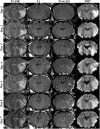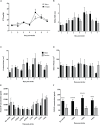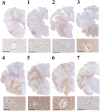Determining the Temporal Profile of Intracranial Pressure Changes Following Transient Stroke in an Ovine Model
- PMID: 31338013
- PMCID: PMC6629870
- DOI: 10.3389/fnins.2019.00587
Determining the Temporal Profile of Intracranial Pressure Changes Following Transient Stroke in an Ovine Model
Abstract
Background and purpose: Cerebral edema and elevated intracranial pressure (ICP) are the leading cause of death in the first week following stroke. Despite this, current treatments are limited and fail to address the underlying mechanisms of swelling, highlighting the need for targeted treatments. When screening promising novel agents, it is essential to use clinically relevant large animal models to increase the likelihood of successful clinical translation. As such, we sought to develop a survival model of transient middle cerebral artery occlusion (tMCAO) in the sheep and subsequently characterize the temporal profile of cerebral edema and elevated ICP following stroke in this novel, clinically relevant model.
Methods: Merino-sheep (27M;31F) were anesthetized and subject to 2 h tMCAO with reperfusion or sham surgery. Following surgery, animals were allowed to recover and returned to their home pens. At preselected times points ranging from 1 to 7 days post-stroke, animals were re-anesthetized, ICP measured for 4 h, followed by imaging with MRI to determine cerebral edema, midline shift and infarct volume (FLAIR, T2 and DWI). Animals were subsequently euthanized and their brain removed for immunohistochemical analysis. Serum and cerebrospinal fluid samples were also collected and analyzed for substance P (SP) using ELISA.
Results: Intracranial pressure and MRI scans were normal in sham animals. Following stroke, ICP rose gradually over time and by 5 days was significantly (p < 0.0001) elevated above sham levels. Profound cerebral edema was observed as early as 2 days post-stroke and continued to evolve out to 6 days, resulting in significant midline shift which was most prominent at 5 days post-stroke (p < 0.01), in keeping with increasing ICP. Serum SP levels were significantly elevated (p < 0.01) by 7 days post-tMCAO.
Conclusion: We have successfully developed a survival model of ovine tMCAO and characterized the temporal profile of ICP. Peak ICP elevation, cerebral edema and midline shift occurred at days 5-6 following stroke, accompanied by an elevation in serum SP. Our findings suggest that novel therapeutic agents screened in this model targeting cerebral edema and elevated ICP would most likely be effective when administered prior to 5 days, or as early as possible following stroke onset.
Keywords: blood-brain barrier; cerebral edema; intracranial pressure; large animal model; stroke.
Figures










Similar articles
-
NK1 tachykinin receptor antagonist treatment reduces cerebral edema and intracranial pressure in an ovine model of ischemic stroke.J Cereb Blood Flow Metab. 2024 Oct;44(10):1759-1773. doi: 10.1177/0271678X241241907. Epub 2024 Mar 28. J Cereb Blood Flow Metab. 2024. PMID: 38546535 Free PMC article.
-
NK1-r Antagonist Treatment Comparable to Decompressive Craniectomy in Reducing Intracranial Pressure Following Stroke.Front Neurosci. 2019 Jul 5;13:681. doi: 10.3389/fnins.2019.00681. eCollection 2019. Front Neurosci. 2019. PMID: 31333402 Free PMC article.
-
Elevated Intracranial Pressure and Cerebral Edema following Permanent MCA Occlusion in an Ovine Model.PLoS One. 2015 Jun 29;10(6):e0130512. doi: 10.1371/journal.pone.0130512. eCollection 2015. PLoS One. 2015. PMID: 26121036 Free PMC article.
-
Management of Intracranial Pressure.Continuum (Minneap Minn). 2015 Oct;21(5 Neurocritical Care):1299-323. doi: 10.1212/CON.0000000000000235. Continuum (Minneap Minn). 2015. PMID: 26426232 Review.
-
Use of hypertonic saline solutions in treatment of cerebral edema and intracranial hypertension.Crit Care Med. 2000 Sep;28(9):3301-13. doi: 10.1097/00003246-200009000-00032. Crit Care Med. 2000. PMID: 11008996 Review.
Cited by
-
NK1 tachykinin receptor antagonist treatment reduces cerebral edema and intracranial pressure in an ovine model of ischemic stroke.J Cereb Blood Flow Metab. 2024 Oct;44(10):1759-1773. doi: 10.1177/0271678X241241907. Epub 2024 Mar 28. J Cereb Blood Flow Metab. 2024. PMID: 38546535 Free PMC article.
-
Glyceryl trinitrate for the treatment of ischaemic stroke: Determining efficacy in rodent and ovine species for enhanced clinical translation.J Cereb Blood Flow Metab. 2021 Dec;41(12):3248-3259. doi: 10.1177/0271678X211018901. Epub 2021 May 26. J Cereb Blood Flow Metab. 2021. PMID: 34039053 Free PMC article.
-
Neurological scoring and gait kinematics to assess functional outcome in an ovine model of ischaemic stroke.Front Neurol. 2023 Feb 20;14:1071794. doi: 10.3389/fneur.2023.1071794. eCollection 2023. Front Neurol. 2023. PMID: 36891474 Free PMC article.
-
CSF Secretion Is Not Altered by NKCC1 Nor TRPV4 Antagonism in Healthy Rats.Brain Sci. 2021 Aug 24;11(9):1117. doi: 10.3390/brainsci11091117. Brain Sci. 2021. PMID: 34573139 Free PMC article.
-
Large animal ischemic stroke models: replicating human stroke pathophysiology.Neural Regen Res. 2020 Aug;15(8):1377-1387. doi: 10.4103/1673-5374.274324. Neural Regen Res. 2020. PMID: 31997796 Free PMC article. Review.
References
-
- Beard D. J., Mcleod D. D., Logan C. L., Murtha L. A., Imtiaz M. S., Van Helden D. F., et al. (2015). Intracranial pressure elevation reduces flow through collateral vessels and the penetrating arterioles they supply. a possible explanation for ‘collateral failure’ and infarct expansion after ischemic stroke. J. Cereb. Blood Flow Metab. 35 861–872. 10.1038/jcbfm.2015.2 - DOI - PMC - PubMed
LinkOut - more resources
Full Text Sources
Other Literature Sources
Research Materials

